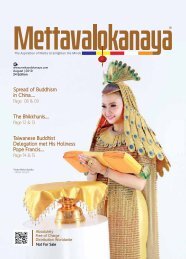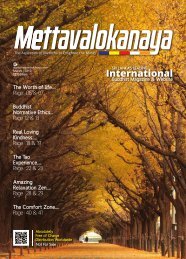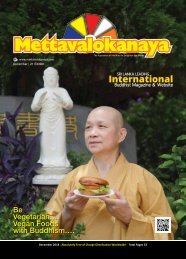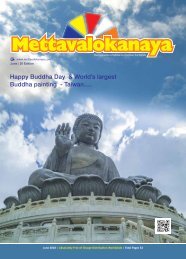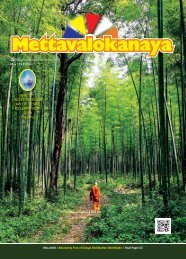#Mettavalokanaya_International_Buddhist_Magazine_November_2021
This is the World’s Most Popular & Leading Monthly International Buddhist Magazine, “Mettavalokanaya” on November 2021 Edition - 33.
This is the World’s Most Popular & Leading Monthly International Buddhist Magazine, “Mettavalokanaya” on November 2021 Edition - 33.
You also want an ePaper? Increase the reach of your titles
YUMPU automatically turns print PDFs into web optimized ePapers that Google loves.
Practically speaking, someone
becomes a Buddhist when,
having taken refuge in the
Buddha, Dhamma and Sangha,
they start to apply themselves to the
study and application of the Buddha’s
teachings in their lives. In Buddhist
countries such as Thailand there
have never been specific ceremonies
in which people may formally affirm
their devotion to Buddhism. This may
be to some extent because Buddhism
is not a religion based on the adoption
of certain beliefs; and also partly
because, there being no Buddhist
proselytism, there have been few new
converts. For better and worse, people
have generally taken their Buddhist
identity for granted, assuming that
they were Buddhist from the day of
their birth.
What are defilements? - The
untrained mind is prey to many
mental states that sully its natural
radiance. These include the various
forms of greed, jealousy, anger,
hatred and animosity, dullness and
agitation, complacency, confusion,
arrogance, contempt and conceit,
and blind attachment to views and
beliefs. Fortunately, none of these
mental states is ‘hard-wired’ into the
mind; everyone may be eliminated
through practice of the Eightfold
Path. These negative, harmful mental
states are called “kilesa” in the Pāli
language, usually rendered in English
as “defilements.” In this book the
term “toxic mental states” has been
preferred to “defilement”.
The reasons for this somewhat
unorthodox rendering are that firstly,
defilement is generally perceived
to be irreversible but kilesa are not;
secondly, because toxic is a familiar
and powerful contemporary word
that illuminates heedless attitudes
towards kilesa, and thirdly, because
it admits of gradation: we can speak
of something as being mildly and
something else as seriously toxic.
Is Buddhism a religion or a
philosophy? - Buddhism can be
puzzling for someone brought up
within one of the great monotheistic
traditions such as Christianity or
Islam. Although Buddhist traditions
give a place to devotion and ceremony,
Buddhism has no dogmas, no single
great book. It involves no worship
of a god. What Buddhism does have
is a mass of teachings that in other
traditions would be considered to
lie within the realm of philosophy
or psychology. For this reason, there
has been much doubts as to whether
Buddhism is a religion at all.
Buddhism certainly does not fit
into the template for religion created
in the Western world. Whether that
signifies that Buddhism is not a
religion at all, or that it is simply a
different kind of religion, is a moot
point. To put the argument for the
second possibility, it might be said
that whereas the religions that grew
up in the Middle East are essentially
belief systems, Buddhism is a system
of education.
The Eightfold Path in more
detail - The Eightfold Path is the
holistic education or training of body,
speech and mind that culminates
in awakening. Right View refers to
beliefs, views, ideals, values that are
in harmony with the way things are.
Initially its most important elements
are confidence in i) the human
capacity for enlightenment, and ii)
the law of kamma.2 Right Thought
refers to thoughts consistent with
Right View. These are characterized
by a freedom from all kinds of toxic
thinking, in particular that which is i)
sensual, ii) hostile or iii) cruel. Right
Thought includes the aspiration to
be free from all inner affliction, and
thoughts of kindness and compassion.
Right Speech is true, useful and
timely speech that is polite and kindly
in intent. It is speech free from i) lying,
ii) harshness, iii) slander and iv) idle
chatter. Right Action refers to actions
that do not harm self or others. At its
most basic it refers to refraining from
i) killing, ii) stealing and iii) sexual
misconduct. Right Livelihood refers to
livelihood that does not cause harm
to self or others. Wrong livelihoods
listed in the texts include the selling
of i) weapons, ii) living beings, iii) meat
and fish, iv) intoxicants and v) poisons.
Right Effort refers to the endeavor
to: i) prevent unskillful thoughts and
emotions that have not yet arisen in
the mind from arising. ii) reduce and
eradicate unskillful thoughts and
emotions that have already arisen in
the mind. iii) introduce into the mind
skillful thoughts and emotions that
have not yet arisen. iv) sustain and
further develop skillful thoughts and
emotions already present in the mind.
Right Mindfulness refers to
maintaining an alert, even-minded
and committed awareness of present
experience, in particular: i) the
physical body ii) the affective tone
of experience: pleasant, unpleasant
or neutral iii) the state of mind iv)
mental phenomena as they relate to
the Buddha’s path of awakening Right
Concentration refers to the inner
stability, clarity and peace experienced
in four stages of “meditative
absorption” or “jhāna”. The first jhāna
is characterized by five ‘jhāna factors’:
an initial and sustained attention to
the meditation object, zest, bliss and
one-pointedness of mind. As the mind
becomes more refined the coarser
jhāna factors fade away. The second
jhāna is reached with the shedding
Become a
Buddhist….
“The path
of the
Buddha”….
Most Venerable Ajahn
Jayasaro Maha Thera
Janamāra Hermitage,
Foot of Khao Yai Mountain
National Park, Nakhon
Ratchasima,
Thailand.
of initial and sustained attention.
The disappearance of zest signals
attainment of the third jhāna. With
the loss of bliss the mind enters
the fourth and most subtle level of
jhāna, distinguished by unshakeable
equanimity.
Life is full of difficulties, and
never free from pain or at least its
possibility. Feeling unsafe and in a
chronic state of lack, human beings
crave a sense of safety and security.
Many seek it through the adoption
of a belief system or the comfort
of rituals. Equally popular is the
path of distraction: pursuing sense
pleasures, wealth, fame, power and
status. In the Buddhist view none
of these strategies achieves its aim.
Sensuality and worldly success
cannot satisfy the deepest human
needs. Faith in dogmas and ritual
observances cannot provide a true
refuge. As long as human beings lack
clear understanding of their lives, and
continue to commit unwise actions,
they can never be secure.
Taking refuge in the “Triple Gem”
(The Buddha, the Dhamma and the
Sangha) is considered to be the first
step to liberation from suffering and
its causes because it gives Buddhists
a grounding and a direction for
their efforts to reach that goal.
Taking refuge signals the first step
of commitment to the path of the
Buddha. Buddhists declare that they
seek refuge in the Buddha as their
teacher and guide; in the Dhamma,
his teachings, as their path; and in the
Sangha, his enlightened disciples, as
their inspiration on the path.
| NOT FOR SALE |
20 l Mettavalokanaya l November l 2021 2021 l November l Mettavalokanaya l 21











